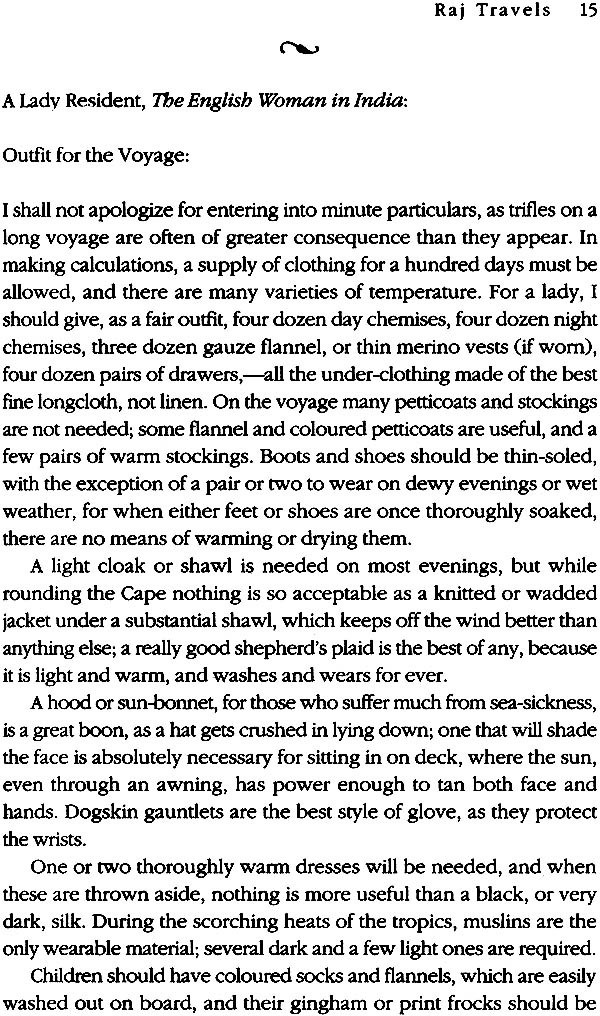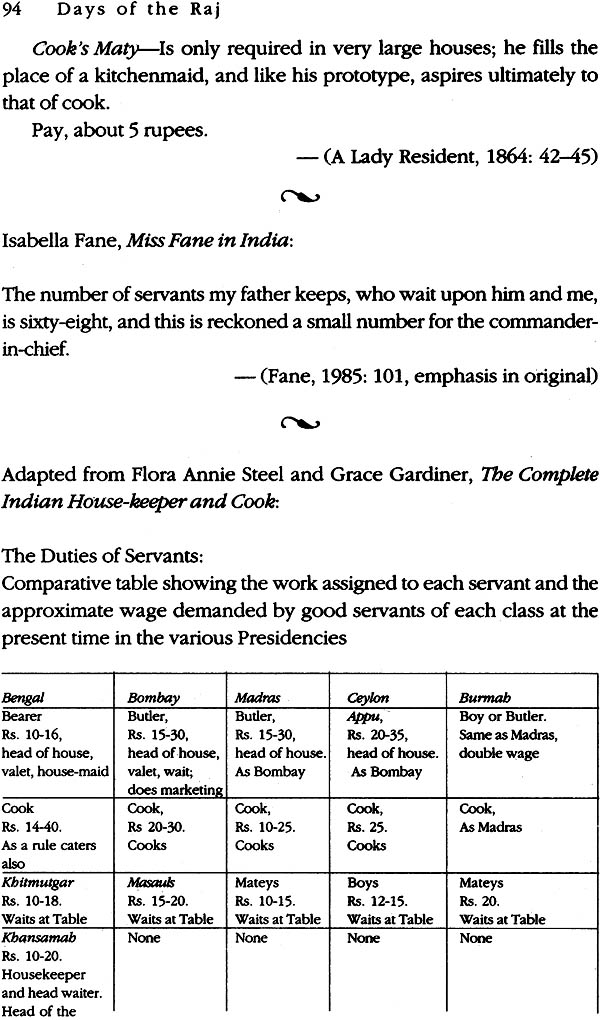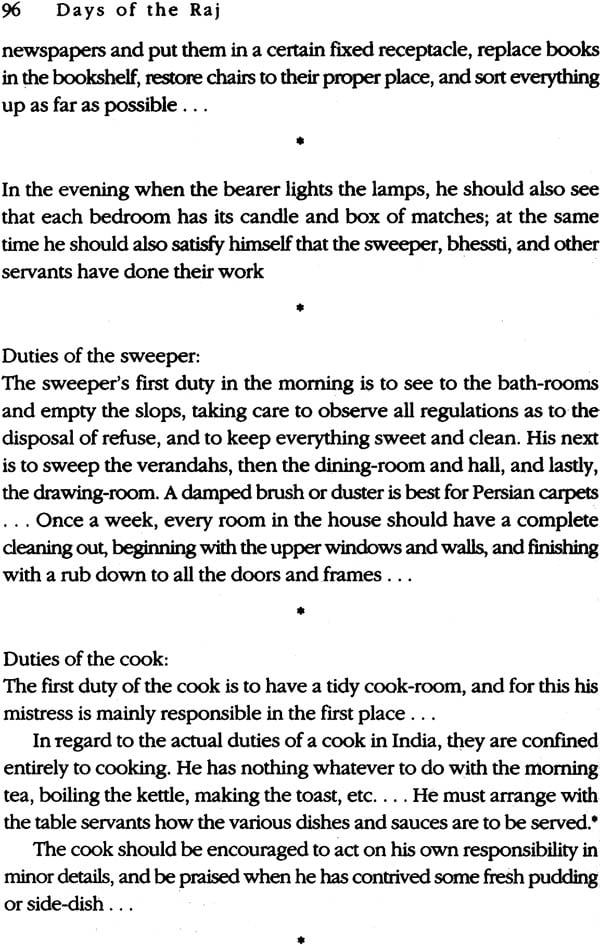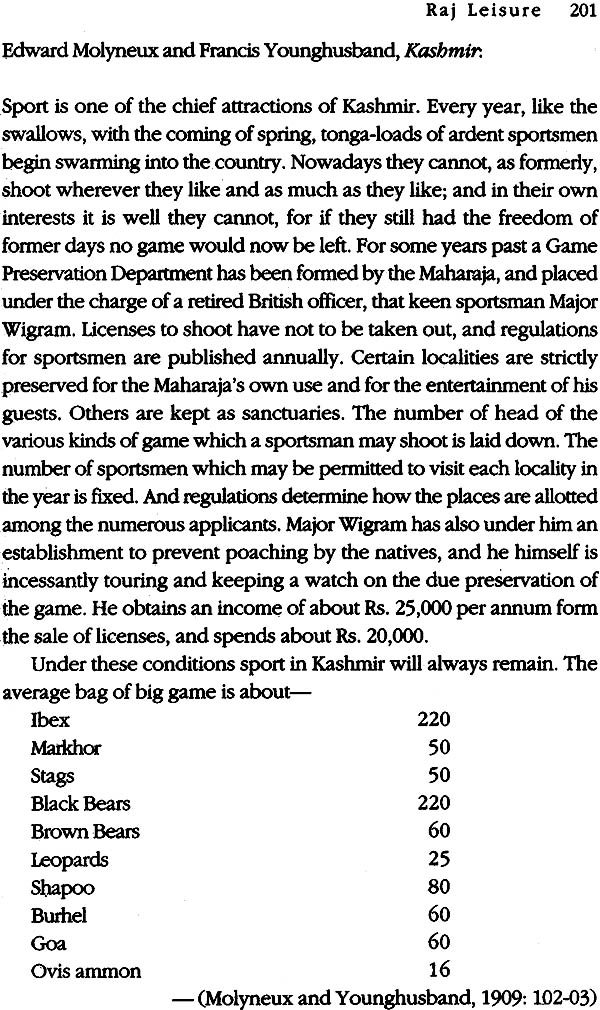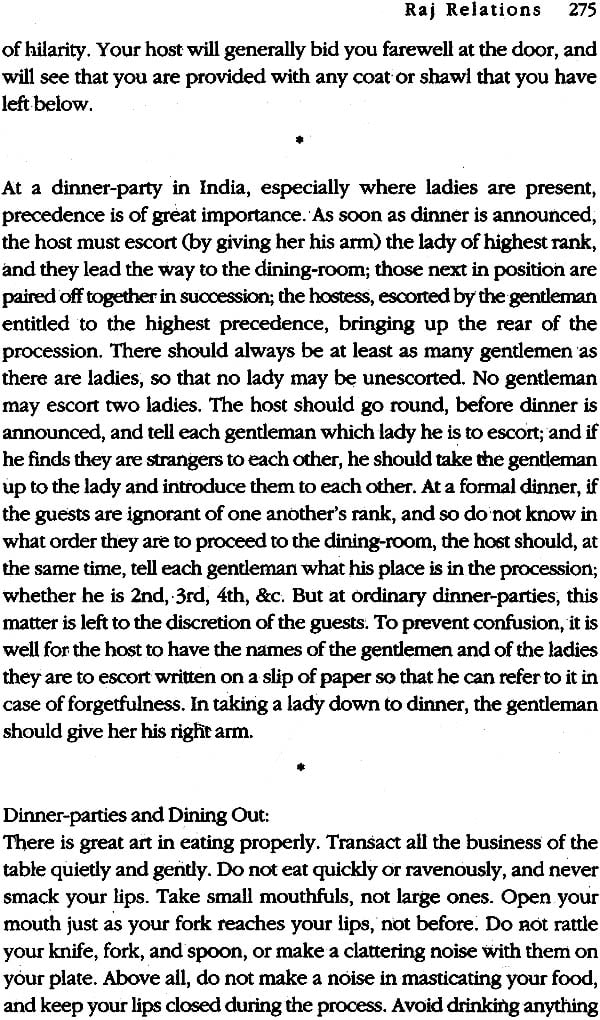
Days of The Raj: Life and Leisure In British India
Book Specification
| Item Code: | NAF679 |
| Author: | Pramod K. Nayar |
| Publisher: | Penguin Books India Pvt. Ltd. |
| Language: | English |
| Edition: | 2009 |
| ISBN: | 9780143102809 |
| Pages: | 324 |
| Cover: | Paperback |
| Other Details | 8.0 inch x 5.0 inch |
| Weight | 270 gm |
Book Description
British India generated the largest imperial archive in the world. From the stacks of administrative reports, minutes, instruction ,manuals, memoirs, letters, reports, cookbooks and travelogues the British left behind, this engaging volume uncovers the minutiae of the social life, leisure and relaxation- the obverse side of the usual picture of the English steadfastly battling the heat and fatigue as they riled India. Days of the Raj reproduces first- hand accounts of homesickness, club culture, mountaineering, Christmas and station parties, and also records British responses to notch girls and the Zenana, mountains and the Ganga, fairs and festivals, elephants and mosquitoes and the monsoon. The celebrated stock characters of the Raj – from the surly Khansamah to the errant syce, from the griffin to the district magistrate’s shopaholic wife- are all here.
Pramod K. Nayar has put together a fascinating account of the lighter side of colonial life in India. This volume provides a vivid and entertaining snapshot of the Raj at leisure.
Pramod K. Nayar teachers at the Department of English, University of Hyderabad, India. He was Smuts Visiting Fellow in Commonwealth Studies (Cambridge University, UK) during 2000- 2001, Charles Wallace India Trust- British Council Fellow (University of Kent at Canterbury) is 2001, and Fulbright Senior Fellow (Cornell ) during 2005-06. His recent books include An Introduction to New media and Cyber cultures (Wiley-Blackwell 2010), Packaging Life: Cultures of the Everyday (Sage 2009), Seeing Stars: Spectacle, Society and Celebrity Culture Sage2009), English Writing and India, 1600-1920: Colonizing Aesthetics ( Routledge, 2008) and The Trial of Bahadur Shah Zafar (edited, Orient BlackSwan,2007). His 1857 Reader and The Great Uprising: India 1857 were published by Penguine in 2007). Digital Cool: Life in the Age of New Media and Raj: The Story of British India are forthcoming from Penguin.
The non- official and leisure life of empire-builders is not often the subject of scrutiny. We know that Julius Caesar, the finest Roman of his age, even though he may not have known it himself, did find pleasure and leisure between his martial, amorous and administrative exploits. The English monarchs waged wars and, having won them, chivvied foxes across the land as a form of relaxation- the foxes clearly did not relax- even as they planned their next ‘outing’.
Empire- builders also have parties and problems with the weather, unctuous servants and unconscious desires. They also need, like ordinary people, to unwind after a hard day’s magisterial work, conquest or profit- making deals, and the British (I use ‘British’ and ‘English’ interchangeably throughout the volume, thought the empire was also won and administered by the Welsh, the Irish and the Scots working for ‘England’) in India- the greatest, wealthiest empire of the nineteenth century-were no exception. Anglo- Indian (i.e. Englishmen and –women in India, in the original sense of the term) social life, leisure pursuits and modes of relaxation constitute a fascinating obverse to the picture we normally see: the hard-working, ruthless, efficient Englishman and the tough ‘Memsahib’ battling heat and fatigue in order to do their duty to their native subjects.
British India left behind, arguably, the largest imperial archive in the world. In the India office Records, British Library, London, East India company material alone occupies 9 miles of shelving! Administrative reports, travelogues, memoirs, letters, censuses, ethnographic studies, commission reports, official minutes and records, instruction manuals …. Every genre has its Raj representative. These are fascinating texts, showing is exactly how an empire was run. But what happened when the Raj, metaphorically of course, let its hair down?
The most entertaining sections of the imperial archive are not about collect orates, famines or the imperial border policy (and this is no surprise, considering the genera l turgidity of government or official prose). It is writing that deal with such mundane things as the right amount of spice in making fish soup or dealing with a truculent dhobi who had just damage the sahib’s shirt that provide us with the most compelling insights into the day- to- day lives of imperial- colonial men and women.
Everyday life was not all colonial pleasure. There was the young recruit to be introduced to the station and shown his place in the scheme of things, even as a case involving two neighbors and a recalcitrant cow threatened to break the peace in the village. Having solved these problems, the exhausted sahib found himself, in the evening, at a complete loss trying to acquire the right tone for expressing condolences to an Indian.
There are the descriptions of encounters with particularly unfriendly tigers during shikars and the Englishman’s jaw-dropping response to the seductive charms of the notch- girl that reveal another dimension of the Raj. There is, as one can see, both information and professional hazards.
Leisure and pleasure are, of course, situated in and governed by the contexts. The early Englishmen in India came as traders pleading for trading rights from the wealthy Mughal empire. Their approaches to the landscape, scenery and leisure were markedly different from the later Englishmen’s. Tentative and often contemptuous, frequently uncomprehending, early travelers like Thomas Roe, Edward Terry and John Fryer lacked any degree of confidence when evaluating India They tried as a result, to stay as English as possible , seeking comfort in the known while living in the midst of the strange.
By the end of the eighteenth century, they had acquired political power and were a commercially successful race. (By 1793 India was making a direct contribution of 500,000 annually to the English exchequer. Blackwood’s Edinburg Magazine of May 1833 debating the ‘East India Question’ reported that since 1814 EIC’s gross receipts amounted to (478,103,1914) Eighteenth- century Englishmen, and a few- women (women started coming out in the last decades of the eighteenth century), found many things charming about India. The intrepid George Forster, Joseph Hooker, William Moorcroft and the later E.P. Stabbing, John Inglis and Francis Young husband collected botanical specimens, spied on Russians at the Afghan border or simply went on personal travels across India. Earnest missionaries William Carey, Henry Martny, Sararh Trucker and other went through villages and districts preaching and others went through villages and districts preaching and setting up churches and schools.
Many Englishmen, now far more confident, entered into liaisons with native women, tried also on India costumes and studied Indian religions and habits. They also began building massive structures- residences, colleges, forts and cantonments – many of which survive to this day. Summe resorts were planned in various places and forests cleared. Instructions for wider roads and better dwellings were issued by Fort William in Bengal and the court of Directors sitting in their building in Leadenhall street, London. Trader East India company was now fully imperial and the Englishman was now striding across the landscape or into his house shouting ‘Qui bai?’ even though a dozen servants were lined up to receive him.
James Rennell’s mapping project of the last decades of the eighteenth century, archaeological excavations and railway lines delivered India to the Englishman. Disappointed that there were no more worlds to conquer or explore, he (mostly ‘he’,sometimes ‘she’ too) turned to the wilds and the Himalayas. Shikar, as a result, became the key leisure sport of the latter half of the nineteenth century. Shikar was also a mode of using a leisure pursuit to highlight imperial control, especially in the wake of the 1857 uprising. Thus the confident (and arrogant) late-nineteenth-century Englishman’s leisure was of a different order altogether. Days of the Raj is a synoptic view of British non-working, or what may loosely be termed their social, life in India. While select excerpts showing their working life have been included, these are meant as contexts—to show how the British worked before their cbottapeg or their tiger hunt. The contexts include several excerpts from the l600-1750 period, even though 'Raj' describes the truly imperial phase after Plassey, 1757, when the trader East India Company became a political power.
The volume opens with the Raj's travel*.—both outward, from England to India, and within India—and English responses to Indian landscape. Excerpts here include advice on the voyage, the experience of dak travel in India, tourist descriptions of mountains, passages showcasing English 'improvements' of India and the fauna and flora. Chapter two, Raj Homes, provides excerpts that describe a colonial's day. It then moves on to their housing and domestic arrangements, including excerpts offering advice on handling servants and bringing up children, their religion and illnesses. It concludes with the empire's food: recipes, advice on kitchen arrangements and tips on how to handle the cook. The third chapter focusses on Raj diversions, ranging from shopping and consumption to gardening and polo to shikar. It includes English writings on and responses to Indian fairs and the nautch girls and their own parties and social gatherings. Chapter Four provides glimpses of English behaviour in India and their relations with Indians, from encountering an emperor to the central role of the ayah in the English household.
Days of the Raj sweeps through the various dimensions of British life in India. The extracts record the responses of English men and -women to nautch girls and the zenana, mountains and the Ganga, fairs and festivals, elephants and mosquitoes, the tiger hunt and the moasoon. It reproduces first-hand experience of homesickness, club culture, mountaineering, Christmas in India, the Indian jugglers and station parties.
The volume uses a range of resources and genres for this purpose: official documents, memoirs, letters, reports, extracts in contemporary periodicals, recipe- and cook-books, instruction manuals and travelogues. It cites lesser-known Raj authors as well as the Emily Edens and Reginald Hebers. It also excerpts from advice books, by both English and native writers. This genre—almost never seen or discussed in works on the Raj—has been chosen for the often quaint, frequently colonial, approach to social interaction between the imperialist and the native. The uneven tenor and texture of the volume is intentional, and captures the many dimensions of an empire. Endnotes provide additional information and bibliographic references for those interested in pursuing particular themes in some detail. The excerpts are intended as a sampling, a foretaste of the other side of Raj writing.1 So dip into the Raj—at (your) leisure.
| Preface | vii | |
| Acknowledgements | xii | |
| 1 | Raj Travels | 1 |
| The Voyage out | 7 | |
| Imperial Landscapes | 19 | |
| travel and Tourism in India | 33 | |
| 2 | Raj Homes | 48 |
| Raj Days | 57 | |
| Housing and Homes | 64 | |
| Religion | 79 | |
| Health Matters | 84 | |
| Domesticity | 87 | |
| Empire Menus | 111 | |
| 3 | Raj Leisure | 125 |
| Commodities and consumption | 131 | |
| The English Social Scene | 140 | |
| Indian Entertainment | 160 | |
| Gardening | 173 | |
| The shikar | 181 | |
| 4 | Raj Relation | 209 |
| Empire Types | 214 | |
| Imperial Relations | 223 | |
| Bibliography | 281 | |
| Glossary of Common Anglo- Indian Terms | 296 | |
| Endnotes | 305 |
